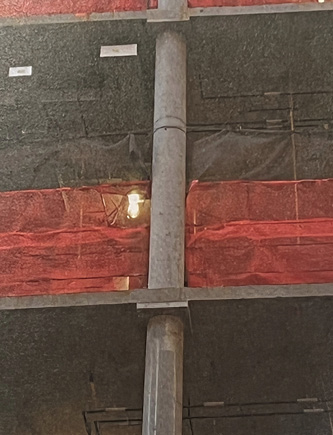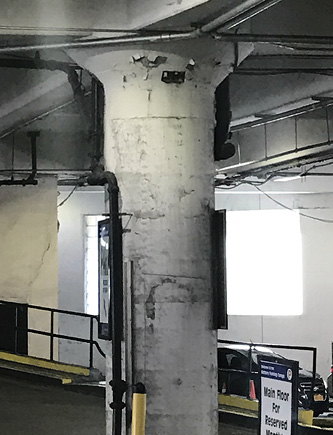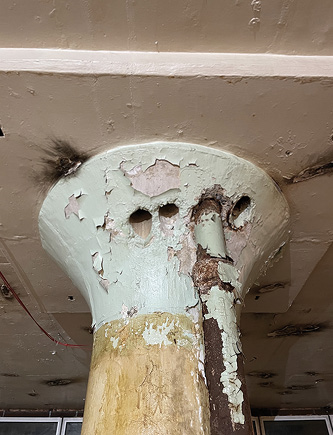THE PROFESSOR ❘ By Glenn Corbett
Structural frames of buildings are composed of two fundamental components—beams and columns. They are the “bones” of buildings, composing the “skeleton” of the structural frame.
Columns are subjected to compressive forces. They transmit a load straight through the length of the column. They can be made of reinforced concrete, steel, or wood as well as older materials such as cast iron or wrought iron. Columns can be created in a variety of shapes; cylindrical and square are the most common.
Building Construction: Understanding Loads and Loading
From a firefighting standpoint, we like columns—the more usually the better. Closely spaced columns mean smaller areas of potential collapse. Situations where columns are widely spaced, such as in the use of transfer beams that allow for loads to be carried over long distances, mean much larger areas of collapse.
Photo 1. This reinforced concrete column uses a “drop panel” to provide shear resistance at the slab, effectively increasing the slab thickness at that location. A similar, slightly smaller version is known as a shear cap. The drop panel is designed to resist a “punching shear” force where the concrete floor slab meets the column. Punching shear involves a concentration of shear force within the floor slab at the column. If the shear resistance of the slab itself is exceeded by the shear force, the floor slab can fail, and the floor moves down past the top of the column.

Photos 1-2, 4-6 by author; photo 3 by Dominick R. DeRubbio.
Photo 2. This “mushroom” column is in a parking garage of Type 1 (fire resistive) construction; the column consists of site-cast concrete and a network of steel reinforcement (“rebar”) inside the concrete. A drop panel is typically found above these columns.

(2)
Photo 3. This mushroom column has been structurally compromised by individuals who have core-drilled holes for metal pipes, removing concrete and potentially destroying the internal steel reinforcement inside. This situation necessitates an immediate inspection by the building official and a thorough analysis by a structural engineer.

(3)
Photo 4. This round steel “lally” column in the basement of an old mercantile building of Type 3 (ordinary) construction, along with the steel beam above, is a new addition to the building—a fire had gutted the basement, and the wooden structural elements were replaced with steel. Lally columns are typically hollow on the interior but may be filled with concrete to provide additional load-carrying capacity.

(4)
Photo 5. This is a solid oak wood column in an old warehouse of Type 4 (heavy timber) construction. Note the cast iron “post cap” at the top of the column. Given that wood shrinks in dimension over time, this component provides a more stable connection as the building ages. When the building was renovated, a steel I-beam (behind the column) was added to provide additional structural strength to the building.

(5)
Photo 6. Tall and slender columns like this steel column are subject to buckling when overloaded. As the length of a column increases, the load-carrying capacity decreases. In this example, it’s difficult to see not only the actual length of the column as it disappears into the overhang but also the load it is carrying.

(6)
Glenn Corbett, P.E., is a former assistant chief of the Waldwick (NJ) Fire Department, an associate professor of fire science at John Jay College of Criminal Justice in New York City, and a technical editor for Fire Engineering. He served on the Federal Advisory Committee of the National Construction Safety Team and is a member of the Fire Code Advisory Council for New Jersey. He is the coauthor of the late Francis L. Brannigan’s Building Construction for the Fire Service, 6th Edition; editor of Fire Engineering’s Handbook for Firefighter I and II; and an FDIC International advisory board member.


